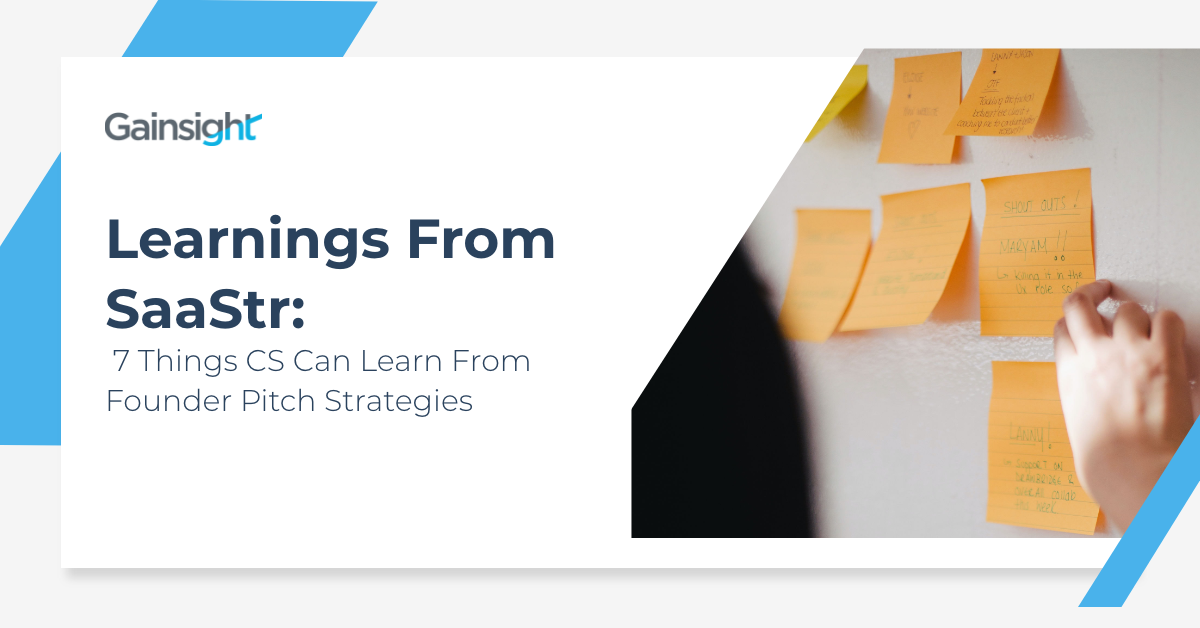For many of us, we are now well past five months in various states of quarantine. Relationships are such a crucial part of sales, and it has become even more difficult without in-person contact. Body language, eye contact, energy, and other ways to gauge connectedness have now been replaced with less impactful digital cues. The pandemic has forced Sales teams to get back to basics to close deals during a tough time for most.
At Gainsight, as CCO, I have been especially focused on our client base to support them through this period. As such, I am always looking for inspiration from other SaaS leaders. I recently listened to a podcast by SaaStr founder Jason Lemkin about “16 Rookie Errors Founders Make Pitching to VCs”. There are a lot of parallels and learnings that CS professionals can use from these tips. I’ve tried to distill a few takeaways here:
1. Cold emails work. But they need to be genuinely remarkable. Every part of them. Going through connections helps, but the best VCs read cold emails. But a cold email has to be especially impressive. Tips: summarize the opportunity, early customers and traction, growth profile, and market size. End with something that’s low drama. “Do you have any time the week after next?” The confident and relatively data-rich but low drama emails work best.
Learnings for CS: Remember when there was a new sponsor at your customer, and you were trying to land that first meeting? Make that email count. Give props to their teammates whom you work with regularly. Share some value metrics (“YTD we’ve saved you $X in costs”). If you don’t have value metrics, share some adoption metrics (“your company is among the top 20 percentile of users among all our customers”). Ask for a minimal amount of time (“15-20 mins works best”) and offer something back to them for their time (“want to understand their priorities, so you can accelerate value” or “can introduce you to other peers who have solved similar challenges”).
2. Not sending the deck ahead of time. Just send it. You are wasting a lot of time, and opportunity potential, by not letting VCs do basic homework ahead of time. Make it easy on them. And send it as a PDF. Build trust. If you are the one selling, don’t put hurdles in front of getting a check. Remove objections. Send the deck. Even if they might email it to someone you’d prefer they didn’t.
Learnings for CS: All of the above. Especially sending as a PDF and not a link. This also means your deck should present itself if you’re not there to present it. For example, each slide’s title should summarize the takeaways from the slide, and the story should flow smoothly to the reader.
3. Not having the >first< slide sell the company all on its own. Just like every email pitch should stand on its own, so should the very first slide of your pitch deck. If the first slide is the only slide you need and sells the whole deal, your odds go up. Elevator pitches are essential. So is a “1-slide” pitch. Make that first slide count. Metrics, team, product, financial goals. Put it all on Slide 1. Position the company, and answer all my questions right then and there. Force yourself to distill the answer of “Why You Should Invest In Me” into one slide, the first slide.
Learnings for CS: This is an excellent tip for Executive Business Reviews. Assume you lose the Executive after the first 15 mins of the planned 60 or 90-min EBR. Write an “Objectives” slide that captures success for the meeting – for you and your customer. Write an Executive Summary that captures the key insights and critical decisions required. I like an Executive Summary that has value delivered to date, challenges/learnings, help needed, and suggested next steps. If you can engage on that one slide, you should count that as a success for the meeting. Writing a robust Executive Summary also forces you to be clear with your storyline and asks.
4. Not doing at least basic homework on the VC firm. You should know their other investments in the space. VCs may be fungible, but no one wants to feel that way. Share why your start-up may be of interest to them based on other investments. That’s, again, Sales 101. And you are selling shares of stock. It’s still sales.
Learnings for CS: Before meeting an Executive at your customers, read their recent press releases. Know if they had any milestone events like M&A, board changes, funding rounds, etc. If they are a public company, read their recent investor reports – it will give you a good idea for their priorities and what might “keep them up at night.” Learn about other customers who are similar to them in size, use-cases, industries, etc. See if they are a Linkedin connection with your close contacts that you can name drop in the conversation.
5. Not answering the questions. If I ask a question, there’s a good reason. Some VCs like to hear themselves talk. I don’t. Just answer it. If you don’t know the answer, let me know. Don’t tell me, “you’ll get to that later.” Because if you do, that may well be too late.
Learnings for CS: It’s ok to jump around in the deck. Assume that the customer has a strong reason to ask the question. You’ll gather a lot of points by answering questions as they come up. By saying “you’ll get to it later,” you are also taking on the responsibility of remembering to come back to the question, and there’s a high risk of completely ignoring the item in the flow of the deck. Or you might run out of time and leave the question unanswered.
6. Not speaking with data. Always speak with data, if data is there. Even if it isn’t great. I don’t want some qualitative answer, once you have even just ten customers.
Learnings for CS: Know every piece of data you put on a slide. There’s nothing that can kill your credibility, like not knowing the data that you have placed on the slide. If you claim to have saved $X or are projecting usage to go up by Y – know why.
7. Poor understanding of the competitive landscape. You have to get this right. You have to. First, always have a competition slide. Second, know it cold. Third, be respectful of any competitor larger than you. If you don’t understand the competitive landscape cold, you don’t understand the market — or what you are going after.
Learnings for CS: All of the above. Have examples of customers that have moved from competitors to your solution and why.
Are you doing all of these for your crucial customer meetings? Gainsight makes preparing for Executive Business Reviews a breeze. Find out how by letting us give you a demo of how we internally prepare for our EBRs.

